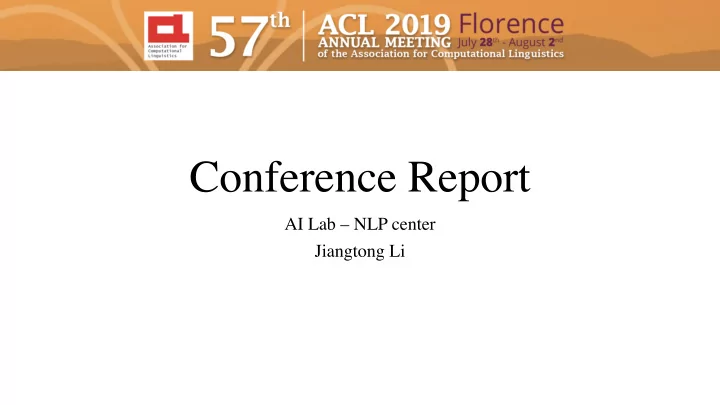

Conference Report AI Lab – NLP center Jiangtong Li
Basic Statistics
Basic Statistics
Basic Statistics
Outline • 1. Bridging the Gap between Training and Inference for Neural Machine Translation • 2. OpenDialKG: Explainable Conversational Reasoning with Attention-based Walks over Knowledge Graphs • 3. Do Neural Dialog Systems Use the Conversation History Effectively? An Empirical Study • 4. Generating Fluent Adversarial Examples for Natural Languages • 5. Dynamically Fused Graph Network for Multi-hop Reasoning • 6. Multi-step Reasoning via Recurrent Dual Attention for Visual Dialog
Bridging the Gap between Training and Inference for Neural Machine Translation • Motivation • At training time, it predicts with the ground truth words as context while at inference it has to generate the entire sequence from scratch. • Word-level training requires strict matching between the generated sequence and the ground truth sequence which leads to overcorrection over different but reasonable translations. • Solution • Use oracle/GT word as the prefix to predict the next word • Word-level oracle: Gumbel-Max sampling • Sentence-level oracle: Beam search sampling
OpenDialKG: Explainable Conversational Reasoning with Attention-based Walks over Knowledge Graphs • Motivation & Tasks • While a large-scale knowledge graph (KG) includes vast knowledge, the core challenge is in the domain-agnostic and scalable prediction of a small subset from those reachable entities that follows natural conceptual threads that can keep conversations engaging and meaningful. • Given a set of KG entity mentions from current turn, and dialog history of all current and previous sentences, the goal is to build a robust model that can retrieve a set of natural entities to mention from a large-scale KG that resemble hu- man responses. • Solution
Do Neural Dialog Systems Use the Conversation History Effectively? An Empirical Study • Motivation & Tasks • A common criticism of current dialogue systems is that they understand or use the available dialog history effectively. • This paper take an empirical approach to understanding how these models use the available dialog history by studying the sensitivity of the models to artificially introduced unnatural changes or perturbations to their context at test time. • Solution • Type of Perturbations • Utterance-level: (1) Shuf (2) Rev (3) Drop (4) Truncate • Word-level: (1) Word-shuf (2) Rev (3) Word-drop (4) Noun-drop (5) Verb-drop
Generating Fluent Adversarial Examples for Natural Languages • Motivation & Tasks • Efficiently building an adversarial attacker for natural language processing is challenging. • Sentence space is discrete and it is difficult to make small perturbations along the direction of gradients. • The fluency of the generated examples cannot be guaranteed. • Solution • Black-box / White-box Attact • Overall Structure • Different lies in the pre-selector • For Black-box • For White-box
Dynamically Fused Graph Network for Multi-hop Reasoning • Motivation & Tasks • A query and a set of accompanying document are given, the answer can only be obtained by selecting two or more evidence from the documents. • Since not every document contain relevant information, multi-hop text-based QA requires filtering out noises from multiple paragraphs and extracting useful information. • Previous work on multi-hop QA usually aggregates document information to an entity graph, and answers are then directly selected on entities of the entity graph. • Solution
Multi-step Reasoning via Recurrent Dual Attention for Visual Dialog • Motivation • After taking a first glimpse of the image and the dialog history, readers often re- visit specific sub-areas of both image and text to obtain a better understanding of the multimodal context. • Solution
Thanks & QA
Recommend
More recommend